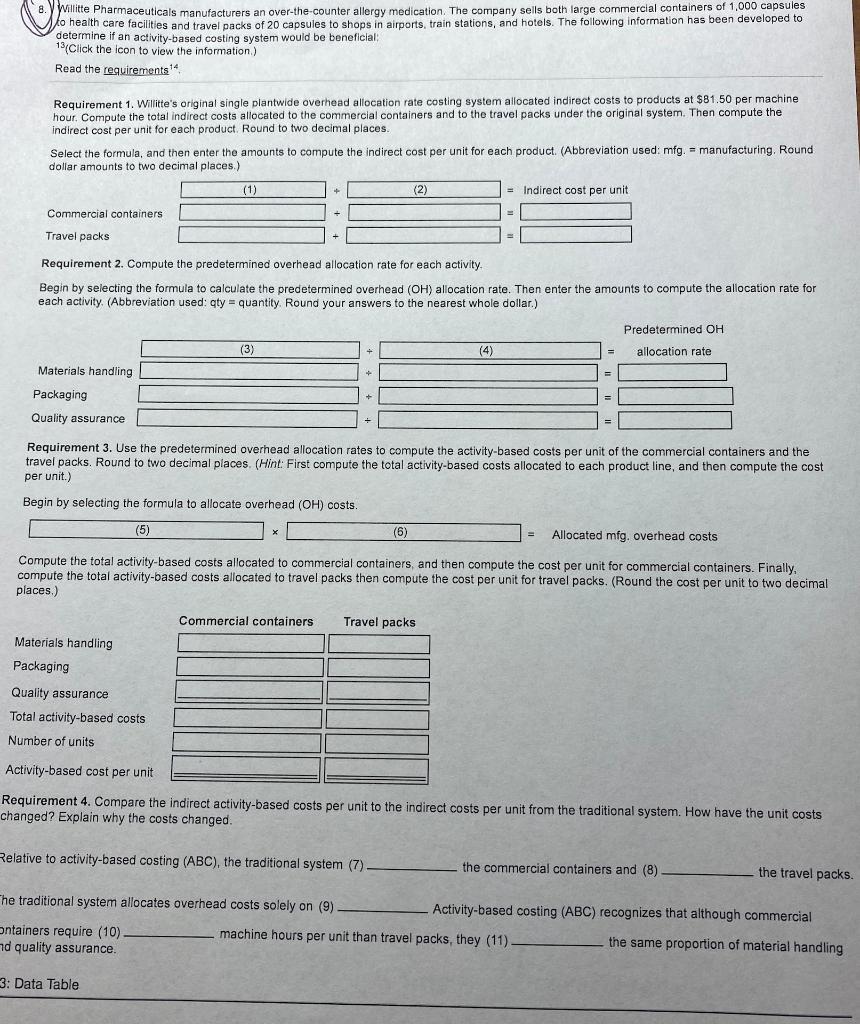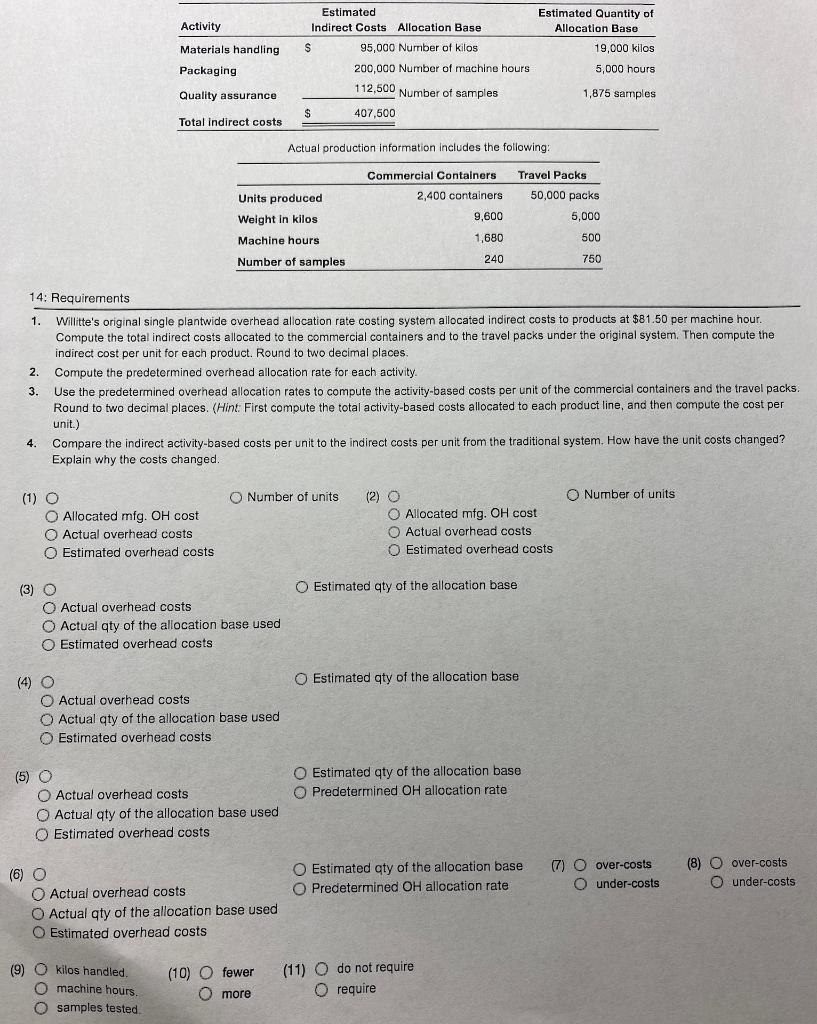

Willitte Pharmaceuticals manufacturers an over-the-counter allergy medication. The company sells both large commercial containers of 1,000 capsules to health care facilities and travel packs of 20 capsules to shops in airports, train stations, and hotels. The following information has been developed to 13 Click the icon to view the information) Read the requirements Requirement 1. Willitte's original single plantwide overhead allocation rate costing system allocated indirect costs to products at $81.50 per machine hour. Compute the total indirect costs allocated to the commercial containers and to the travel packs under the original system. Then compute the indirect cost per unit for each product. Round to two decimal places. Select the formula, and then enter the amounts to compute the indirect cost per unit for each product. (Abbreviation used: mfg. = manufacturing. Round dollar amounts to two decimal places.) (1) (2) = Indirect cost per unit Commercial containers = Travel packs Requirement 2. Compute the predetermined overhead allocation rate for each activity Begin by selecting the formula to calculate the predetermined overhead (OH) allocation rate. Then enter the amounts to compute the allocation rate for each activity. (Abbreviation used: qty = quantity. Round your answers to the nearest whole dollar.) Predetermined OH (3) (4) allocation rate Materials handling Packaging = = Quality assurance Requirement 3. Use the predetermined overhead allocation rates to compute the activity-based costs per unit of the commercial containers and the packs. Round to two decimal places (Hint: First compute the total activity-based costs allocated to each product line, and then compute the cost per unit) Begin by selecting the formula to allocate overhead (OH) costs. (5) x (6) Allocated mfg. overhead costs Compute the total activity-based costs allocated to commercial containers, and then compute the cost per unit for commercial containers. Finally, compute the total activity-based costs allocated to travel packs then compute the cost per unit for travel packs. (Round the cost per unit to two decimal places.) Commercial containers Travel packs Materials handling Packaging Quality assurance Total activity-based costs Number of units Activity-based cost per unit Requirement 4. Compare the indirect activity-based costs per unit to the indirect costs per unit from the traditional system. How have the unit costs changed? Explain why the costs changed. Relative to activity-based costing (ABC), the traditional system (7) the commercial containers and (8) the travel packs The traditional system allocates overhead costs solely on (9) Activity-based costing (ABC) recognizes that although commercial ontainers require (10) machine hours per unit than travel packs, they (11) the same proportion of material handling hd quality assurance. 3: Data Table Activity Estimated Indirect Costs Allocation Base $ 95,000 Number of kilos 200,000 Number of machine hours Estimated Quantity of Allocation Base 19,000 kilos 5,000 hours Materials handling Packaging 112,500 Number of samples Quality assurance 1,875 samples $ 407,500 Total Indirect costs Actual production information includes the following: Units produced Weight in kilos Machine hours Commercial Containers 2,400 containers 9,600 1,680 Travel Packs 50,000 packs 5,000 500 Number of samples 240 750 14: Requirements 1. Willitte's original single plantwide overhead allocation rate costing system allocated indirect costs to products at $81.50 per machine hour. Compute the total indirect costs allocated to the commercial containers and to the travel packs under the original system. Then compute the indirect cost per unit for each product. Round to two decimal places. 2. Compute the predetermined overhead allocation rate for each activity 3. Use the predetermined overhead allocation rates to compute the activity-based costs per unit of the commercial containers and the travel packs. Round to two decimal places. (Hint First compute the total activity-based costs allocated to each product line, and then compute the cost per unit.) 4. Compare the indirect activity-based costs per unit to the indirect costs per unit from the traditional system. How have the unit costs changed? Explain why the costs changed. O Number of units Number of units (1) O Allocated mfg. OH cost Actual overhead costs O Estimated overhead costs (2) O O Allocated mig. OH cost Actual overhead costs Estimated overhead costs O Estimated qty of the allocation base (3) O O Actual overhead costs O Actual aty of the allocation base used O Estimated overhead costs O Estimated qty of the allocation base (4) O Actual overhead costs Actual qty of the allocation base used O Estimated overhead costs Estimated qty of the allocation base Predetermined OH allocation rate (5) O Actual overhead costs Actual qty of the allocation base used O Estimated overhead costs O Estimated aty of the allocation base O Predetermined OH allocation rate (7) O over-costs O under-costs (8) O over-costs under-costs (6) O Actual overhead costs Actual qty of the allocation base used O Estimated overhead costs (9) O kilos handled. O machine hours. O samples tested. (10) O fewer O more (11) O do not require O require








